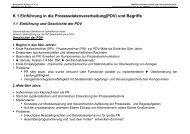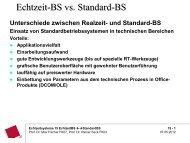OS-9 for the Prospector P1100 Board Guide
OS-9 for the Prospector P1100 Board Guide
OS-9 for the Prospector P1100 Board Guide
You also want an ePaper? Increase the reach of your titles
YUMPU automatically turns print PDFs into web optimized ePapers that Google loves.
Implementation Overview<br />
The Fastboot configuration flags have been implemented as a set of bit<br />
fields. An entire 32-bit field has been dedicated <strong>for</strong> bootstrap configuration.<br />
This four-byte field is contained within <strong>the</strong> set of data structures shared by<br />
<strong>the</strong> ModRom sub-components and <strong>the</strong> kernel. Hence, <strong>the</strong> field is available<br />
<strong>for</strong> modification and inspection by <strong>the</strong> entire set of system modules<br />
(high-level and low-level). Currently, <strong>the</strong>re are six bit flags defined with eight<br />
bits reserved <strong>for</strong> user-definable bootstrap functionality. The reserved<br />
user-definable bits are <strong>the</strong> high-order eight bits (31-24). This leaves bits<br />
available <strong>for</strong> future enhancements. The currently defined bits and <strong>the</strong>ir<br />
associated bootstrap functionality are listed below:<br />
B_QUICKVAL<br />
The B_QUICKVAL bit indicates that only <strong>the</strong> module headers of modules in<br />
ROM are to be validated during <strong>the</strong> memory module search phase. This<br />
causes <strong>the</strong> CRC check on modules to be omitted. This option is a potential<br />
time saver, due to <strong>the</strong> complexity and expense of CRC generation. If a<br />
system has many modules in ROM, where access time is typically longer<br />
than RAM, omitting <strong>the</strong> CRC check on <strong>the</strong> modules will drastically<br />
decrease <strong>the</strong> bootstrap time. It is rare that corruption of data will ever occur<br />
in ROM. There<strong>for</strong>e, omitting CRC checking is usually a safe option.<br />
B_OKRAM<br />
The B_OKRAM bit in<strong>for</strong>ms both <strong>the</strong> low-level and high-level systems that<br />
<strong>the</strong>y should accept <strong>the</strong>ir respective RAM definitions without verification.<br />
Normally, <strong>the</strong> system probes memory during bootstrap based on <strong>the</strong><br />
defined RAM parameters. This allows system designers to specify a<br />
possible RAM range, which <strong>the</strong> system validates upon startup. Thus, <strong>the</strong><br />
system can accommodate varying amounts of RAM. In an embedded<br />
system where <strong>the</strong> RAM limits are usually statically defined and presumed<br />
to be functional, however, <strong>the</strong>re is no need to validate <strong>the</strong> defined RAM list.<br />
Bootstrap time is saved by assuming that <strong>the</strong> RAM definition is accurate.<br />
34 <strong>OS</strong>-9 <strong>for</strong> <strong>the</strong> <strong>Prospector</strong> <strong>P1100</strong> <strong>Board</strong> <strong>Guide</strong>





